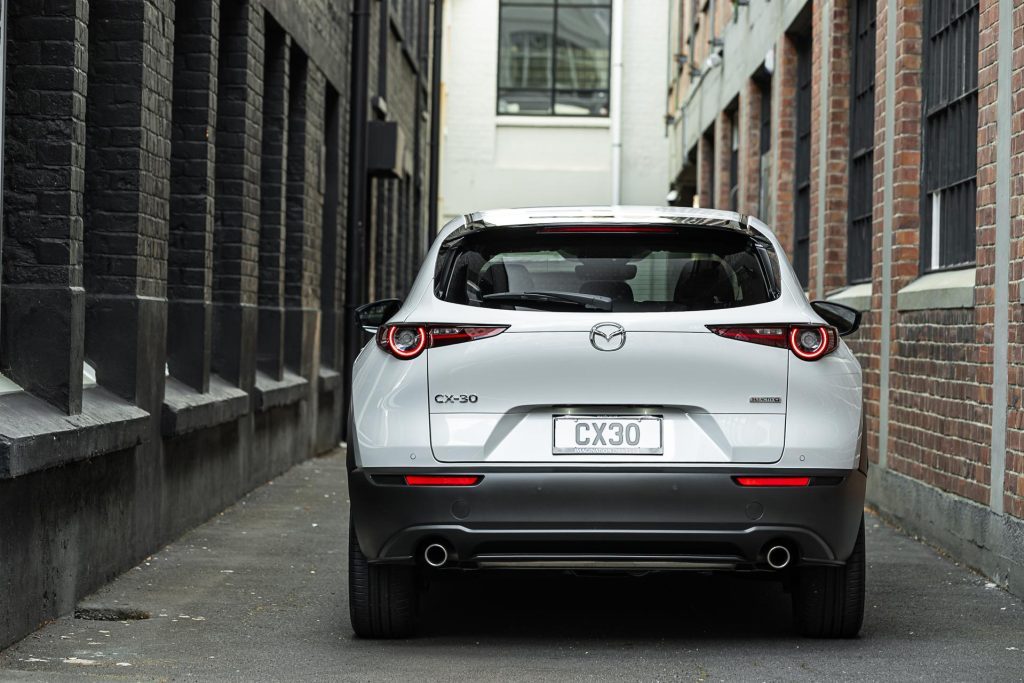2024 Mazda CX-30 SP25 review
Words: Peter Louisson | Photos: Isaac Western
There’s the oddest dichotomy between Australia and New Zealand at present, and that’s the performance of Mazda in each nation.
Over the ditch, the Japanese brand continues to be one of the top sellers of new vehicles. And that was true for New Zealand until a few years ago when the slide began. In 2023 Mazda didn’t even figure amongst the top ten.
Why, you might wonder? Well, Australia is behind the eight-ball on electrification compared with New Zealand.

Vehicles like the Mazda BT-50 are still popular over there, and so too the range of SUVs offered by Mazda.
Mazda’s sole electric model, the Mazda MX-30, has not sold well, and was culled from the Australia line-up, though is still on sale here.
Elsewhere, there are only a couple of mild hybrids and one plug-in option. By contrast, two-thirds of Toyota’s fleet is electrified. However, Mazda promises more electrification from next year.

Meantime, what of the facelifted CX-30 range? There are no motors in any of these (engines only) but we do get a new SP25 model, pictured here. And the petrol donks are said to be more efficient, while the cars are better equipped.
This vehicle is the second in the line-up of four. The base GSX remains a front-drive small crossover with a 2.0L SkyActiv-G petrol engine that now features cylinder deactivation (7.0L/100km).

There are two models with the 139kW/252Nm 2.5L naturally aspirated engine, this front driver and the Limited AWD variant which is better specified and costs $53,790.
The range-topping Takami is also AWD and runs the e-SkyActiv X engine, a 2.0 compression-ignition petrol mill (6.7L/100km, $57,790). All but Takami run merrily on 91 unleaded fuel.
We’d say we’ve probably driven the pick of the bunch. And what a delight it is once again to drive a vehicle that is so NOT digital. Why there’s not even a touchscreen. And there are buttons for stuff.

And it doesn’t bong or chime at you. Even the traffic sign recognition couldn’t give a toss if you overspeed. So we did, a lot.
And you forget just how light and agile non-EVs are. This compact crossover weighs in at 1466kg, and is just a joy to chuck into corners.
Unless you’re going mental it will exit with a smile on its face about as big as the one you’re wearing.

And it’s even easy on gas given the performance it’s capable of. Hit it hard and you might see double figures but drive it carefully and you could well match the 7.3 WLTP quoted average.
We drove it with some enthusiasm and it still managed plenty of figures in the eights (the long term average was 8.5).
Hot to trot
This goes much better than the performance figures (0-100 in 8sec) might suggest.
In town you can ease about with around 2000rpm showing, out of town it goes okay in the 2000-3000rpm range, and we used 3000-4000rpm much of the time out in the boonies, shifting manually with the lever.

No paddles here, not needed. Nice brakes too, with no hint of regeneration anywhere so they’re progressive and predictable at the pedal.
True, there are only six speeds in the auto. That’s no biggie though because the bristling midrange fills in the gaps and in top it’s geared long, 100km/h a gentle 1800rpm.
The cabin is quiet on the go too, with just a hint of road roar from the sticky Sportmax rubber (71.5dB tops).

Steering this is fun. You’d not credit how it holds a line and cornering speeds are nearly sports sedan-like. Even more surprising is that it runs a semi-independent rear end, with its torsion bar set-up.
Still, the ride is quite passable and it also translates to 430L of boot space, expanding to 1432L when brimmed to the roofline.
Not bad for something that’s under 4.4m in length. Enough for a small family then, not that rear seat space will thrill teens.

How does it weigh so little? Well, there’s no battery pack, other than the 12 volter. There’s no powered fifth door or seat mechanisms, all manual.
And while it comes with dual zone air and head-up display, there’s no Qi charger or sunroof, and no seat heaters. No faux leather either. The Limited gets all the fluff.
But you do get some good stuff like adaptive cruise control, wireless phone connection plus USB-C chargers, shiny 18-inch black alloys, and all the expected safety features sufficient to render it a strong five-star ANCAP figure.

Plus there’s the peace of mind that comes with a five-year/unlimited km warranty, along with five years of free servicing and roadside assistance.
So Mazda’s CX-30 SP25 is as charming to drive as it looks.
We rate it right up there with the best compact crossovers available at present. And not a jot of electrification in sight.
| Model | Mazda CX-30 |
| Price | $45,990 |
| Engine | 2488cc, IL4, DI, T |
| Power | 139kW |
| Torque | 252Nm |
| Drivetrain | 6-speed auto, FWD |
| 0-100 km/h | 8.06s |
| Fuel Use | 7.5L/100km |
| C02 Output | 171g/km |
| Weight | 1466kg (claimed) |
This story first appeared in the May 2024 issue of NZ Autocar magazine.





